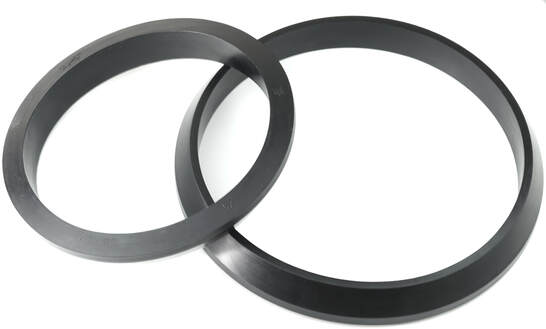Understanding Precision Industrial Gear Systems
A precision industrial gear is a critical component in modern machinery, enabling the transfer of torque and motion with minimal energy loss. Unlike other transmission methods such as belts or chains, gear-driven systems deliver unmatched efficiency, reliability, and stability. With applications ranging from automotive systems to aerospace engineering, precision gear technology underpins nearly every sector that relies on mechanical power. In this blog post, Longruifa will share the important role of precision industrial gear in mechanical power transmission, its features, applications, etc.
Key Features of Precision Industrial Gear Transmission
The popularity of precision gears lies in their superior performance characteristics. The following features highlight why industrial precision gears are indispensable in advanced mechanical systems:
1. High Transmission Efficiency
Precision gear drives typically operate at an efficiency level above 95%. This means minimal energy is lost during torque transfer, making them ideal for both high-speed and heavy-load applications. In industries where energy conservation and output optimization are critical, gears provide an undeniable advantage.
2. Stable Transmission Ratio
Unlike belt or chain systems, precision gear mechanisms maintain a consistent transmission ratio. Both average and instantaneous values remain constant, ensuring stable motion. This stability is especially valuable in automation, robotics, and aerospace, where even small deviations could result in performance failure.
3. Compact and Robust Structure
A precision industrial gear system can transmit significant power while maintaining a relatively small footprint. Its compact design makes it well-suited for applications where space is limited, such as automotive transmissions and robotic joints. Despite their smaller size, these gears maintain high load capacity and durability.
4. High Load-Bearing Capacity
Due to robust materials and advanced manufacturing techniques, precision gears can withstand heavy loads without compromising accuracy. This is why they are commonly used in cranes, turbines, and heavy-duty manufacturing equipment.
5. Long Service Life and Reliability
Properly designed gears, made from high-strength alloys and treated with surface hardening, can last for decades. Their reliability reduces downtime in industrial systems, offering cost-effective long-term performance.
6. Wide Speed Application Range
From low-speed heavy-duty conveyors to ultra-high-speed turbine drives, industrial precision gears can operate across a broad speed spectrum. Their adaptability makes them a universal choice across diverse mechanical sectors.
Classification of Precision Industrial Gear Systems
To better understand the scope of gear technology, it is useful to categorize precision industrial gear transmissions based on different criteria:
By Gear Type
-
Spur Gears – Straight-tooth cylindrical gears used in moderate-speed applications.
-
Helical Gears – Angled-tooth gears offering smoother engagement and higher load capacity.
-
Bevel Gears – Cone-shaped gears used for intersecting shafts.
-
Herringbone (Double Helical) Gears – Designed to eliminate axial thrust, suitable for heavy loads.
By Installation Form
-
Closed Transmission Systems – Found in gearboxes with strong housing, offering excellent lubrication and protection (e.g., automobile transmissions).
-
Open Transmission Systems – Exposed gears, common in agricultural or construction machinery, where lubrication may be less controlled.
-
Semi-Open Systems – Featuring protective covers and oil baths for moderate conditions.
By Function
-
Power Transmission Gears – Built to handle high torque transfer, often used in heavy industrial and automotive applications.
-
Motion Transmission Gears – Focused on precision movement, such as in robotics and clock mechanisms.
By Surface Hardness
-
Soft Gear Surfaces (<350 HBW) – Easier to manufacture but less durable under heavy load.
-
Hard Gear Surfaces (>350 HBW) – More expensive to produce but designed for long-term use in demanding applications.
Applications of Precision Industrial Gear in Modern Industries
The versatility of precision industrial gear systems allows them to serve a wide range of industries, powering essential machinery and ensuring reliable operation.
Automotive Industry
From engine timing gears to transmission and differential systems, gears are fundamental in converting engine power into controlled vehicle motion. Precision gears enable smooth acceleration, fuel efficiency, and reduced vibration in modern automobiles.
Industrial Machinery
Machine tools, conveyor systems, and cranes rely heavily on precision gear mechanisms for stable torque transmission. In heavy industries, gears are essential for reliable operation under continuous load.
Aerospace Engineering
Aircraft engines, helicopter rotor drives, and spacecraft require gears with extreme precision and durability. A precision industrial gear system ensures stable power transmission under high stress, vibration, and extreme temperature variations.
Household Appliances
Everyday machines such as washing machines, mixers, and electric drills use compact gear systems to deliver the necessary torque for functionality. Although small in size, these gears must still meet durability and noise-reduction requirements.
Timekeeping and Micro-Mechanics
Mechanical watches and precision instruments rely on miniature gears to ensure accurate movement. Here, the emphasis shifts from load-bearing to ultra-high precision.
Marine Industry
Ship propulsion systems and marine engines use gears to efficiently transmit power from turbines or engines to propellers. Their reliability ensures safe and effective vessel operation.
Renewable Energy – Wind Power
Wind turbines rely on industrial gearboxes to increase rotor speed for electricity generation. Precision gear design improves energy capture efficiency and durability under harsh environmental conditions.
Robotics and Automation
Robotic arms, autonomous vehicles, and automated production lines require gears that combine compactness, precision, and high strength. Precision gear technology ensures accurate motion control in robotics, which is vital for assembly lines and medical robotics.
Challenges and Considerations in Precision Industrial Gear Design
While gears provide immense advantages, they also present challenges in design and operation:
-
Manufacturing Precision – Gears require high-accuracy machining and strict tolerances, which increases production costs.
-
Lubrication Needs – Proper lubrication is crucial to prevent wear, noise, and heat buildup.
-
Noise and Vibration – At high speeds, even minor imperfections can cause significant noise and vibration.
-
Cost Factor – Compared to chain or belt drives, precision gears are more expensive to design and manufacture.
Future Trends in Precision Industrial Gear Technology
As industries evolve, so too does gear technology. Some emerging trends include:
-
Lightweight Composite Materials – Reducing gear weight without sacrificing strength.
-
Additive Manufacturing (3D Printing) – Allowing for complex gear geometries and faster prototyping.
-
Smart Gear Systems – Integration of sensors for real-time monitoring of wear, vibration, and temperature.
-
Eco-Friendly Gear Lubricants – Enhancing efficiency while reducing environmental impact.
Conclusion
The precision industrial gear remains an irreplaceable component in mechanical power transmission. Its efficiency, stability, and adaptability make it a cornerstone in industries as diverse as automotive, aerospace, energy, and robotics. As new technologies emerge, gears will continue to evolve, becoming smarter, lighter, and more efficient while maintaining their fundamental role in powering the machinery of tomorrow.
www.lrfgears.com
Longruifa


